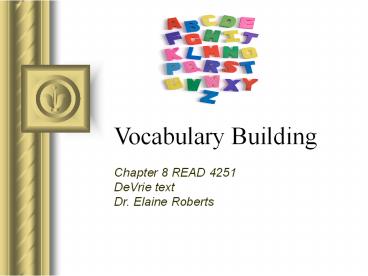Vocabulary Building PowerPoint PPT Presentation
1 / 15
Title: Vocabulary Building
1
Vocabulary Building
- Chapter 8 READ 4251
- DeVrie text
- Dr. Elaine Roberts
2
What Teachers Need to Know about Building
Vocabulary
- How proficient readers enrich their vocabulary
- How to assess vocabulary
- How to build struggling readers vocabulary
3
Factors Influencing a Childs Vocabulary
- Life experiences
- Vicarious experiences (videos, TV, movies,
CD-ROMs, Internet, books, etc.) - Direct instruction
4
Five Ingredients for Direct Instruction of
Vocabulary
- Words must be learned in context
- Words must be related to previous knowledge
- Words must be fully understood so students can
use them in new situations - Students need to use, hear, and see the words
repeatedly - Teachers need to enjoy learning new words
5
Assessment of Vocabulary
- Informal assessment
- Cloze tests
- Maze tests
- Zip tests
- Formal assessment
- Standardized achievement tests
- Group diagnostic tests
- Individual diagnostic reading tests
6
Lucy Calkins Twist on Vocabulary from her books,
The Art of Reading and The Art of Writing
- Students profit from read alouds, book talks,
book introductions with geared towards rehearsing
and talking about words and concepts in a book - Pronounce unknown word and replace it with a
synonym that works in the same sentence (build
webs of words that are synonyms) - Hang onto meaning and take a stab at the
meaning from context through life experience
related discussions - Students benefit more from extensive reading with
vocabulary discussions related to authors style
rather than kill and drill - The dictionary is for use after students try the
above
7
Graphic Organizer Demonstrating a Hierarchy of
Word Relationships
8
What Does This Checklist Reveal about Students
Vocabulary?
9
Language Experience Approach (LEA) for Vocabulary
Instruction
- Reading, writing, and the other language arts are
treated as interrelated - Childrens experiences are used as the basis for
the material used in reading and writing - Share an experience with students
- Discuss what they have experienced
- Use technical terms during this discussion
- Serve as a scribe for students as they create
webs about the experience - Have the students dictate sentences about the
experience - Write the text in the exact way the students
dictate it - Have the students read the passage
- Discuss sentences that are awkward and change
them - For vocabulary instruction, have the students
dictate a passage that includes new words and
then read it
10
Variations of the LEA
- Wordless books
- Science experiments
- Listening walk
- Schoolyard safari
- Cloud formations
- Object descriptions
11
Strategies for Vocabulary Building
- Categorizing
- Possible Sentences
- Analogies
- Exploring word origins
- Crossword puzzles
- Synonym/Definition Concentration
- Wordo
- Concept of a Definition
12
Strategies for Vocabulary Building (cont.)
- Scattergory
- Multiple Meaning Race Track
- Hink pinks
- Dictionary guide words
- Locating the correct dictionary definition
- Anticipation Guides (Voc and Comprehension)
- Personal Clue Cards
13
Possible Sentences Based on New Vocabulary
14
Literature Circles Enhance Vocabulary and
Comprehension
- Heterogeneous groups read a book of interest and
make connections, debate and challenge each
other, and ask open ended questions student
centered - Teacher is the floating facilitator and is
usually not a member of any group - First, model and practice the literature circle
roles with emphasis on grand conversations for a
week with student tryouts - Daniels six roles (role sheets are online)
- 1. Artful Artist
- 2. Word Wizard (Word Id and Vocabulary)
- 3. Discussion Leader (themes, style, etc.)
- 4. Dramatic Reenactor (quotes, favorite parts)
- 5. Story Elements Correspondent (characters,
place, plot, etc.) - 6. Personal Connector
15
Activity for the Literature Circle Strategy
- Select members for the Literature Circles
- Assign roles for the members of each circle
- Assign reading to be completed by the circles
inside or outside of class - Select circle meeting dates
- Help students prepare for their roles in their
circle - Act as a facilitator

